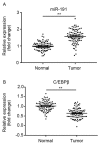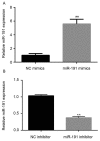MicroRNA-191 targets CCAAT/enhanced binding protein β and functions as an oncogenic molecule in human non-small cell lung carcinoma cells
- PMID: 31316611
- PMCID: PMC6601399
- DOI: 10.3892/etm.2019.7668
MicroRNA-191 targets CCAAT/enhanced binding protein β and functions as an oncogenic molecule in human non-small cell lung carcinoma cells
Abstract
The aberrant expression of microRNAs (miRs) may be involved in tumor growth and progression in human non-small cell lung carcinoma (NSCLC). The present study aimed to investigate the potential roles of miR-191 in NSCLC. Western blotting and reverse transcription-quantitative polymerase chain reaction were performed to assess protein and/or mRNA levels. Scratch wound healing and transwell assays were performed to determine the NSCLC cell migration and invasion. A luciferase demonstrated that CCAAT/enhanced binding protein β (C/EBPβ) was a target of miR-191. Previously, miR-191 has been reported to act as an oncogenic player in multiple human cancers. C/EBPβ has been identified as a target gene of miR-191; however, the roles and underlying mechanisms of miR-191 associated with the regulation of tumor invasion in NSCLC remain unknown. In the present study, it was demonstrated that miR-191 expression levels were higher in human NSCLC tumors compared with in normal adjacent tissue and elevated miR-191 expression levels were closely associated with tumor node metastasis stage in patients with NSCLC. Furthermore, transfection with miR-191 mimic inhibited C/EBPβ expression at the mRNA and protein levels and promoted A549 cell migration and invasion. C/EBPβ was reported to be the direct target gene of miR-191 using a dual luciferase reporter assay. Finally, C/EBPβ siRNA can mimic the effects of miR-191. These findings indicated that miR-191 may function as an oncogene in NSCLC, at least partially due to its negative regulatory on C/EBPβ.
Keywords: CCAAT/enhanced binding protein β; metastasis; microRNA-191; negative regulation; non-small cell lung carcinoma.
Figures








Similar articles
-
Effect of microRNA-135a on Cell Proliferation, Migration, Invasion, Apoptosis and Tumor Angiogenesis Through the IGF-1/PI3K/Akt Signaling Pathway in Non-Small Cell Lung Cancer.Cell Physiol Biochem. 2017;42(4):1431-1446. doi: 10.1159/000479207. Epub 2017 Jul 17. Cell Physiol Biochem. 2017. PMID: 28715819
-
Downregulation of N-Acetylglucosaminyltransferase GCNT3 by miR-302b-3p Decreases Non-Small Cell Lung Cancer (NSCLC) Cell Proliferation, Migration and Invasion.Cell Physiol Biochem. 2018;50(3):987-1004. doi: 10.1159/000494482. Epub 2018 Oct 24. Cell Physiol Biochem. 2018. PMID: 30355927
-
MicroRNA-215 suppresses the proliferation, migration and invasion of non-small cell lung carcinoma cells through the downregulation of matrix metalloproteinase-16 expression.Exp Ther Med. 2018 Apr;15(4):3239-3246. doi: 10.3892/etm.2018.5869. Epub 2018 Feb 14. Exp Ther Med. 2018. PMID: 29545841 Free PMC article.
-
MicroRNA-183 Acts as a Tumor Suppressor in Human Non-Small Cell Lung Cancer by Down-Regulating MTA1.Cell Physiol Biochem. 2018;46(1):93-106. doi: 10.1159/000488412. Epub 2018 Mar 20. Cell Physiol Biochem. 2018. PMID: 29587281
-
MicroRNA-361-3p suppresses tumor cell proliferation and metastasis by directly targeting SH2B1 in NSCLC.J Exp Clin Cancer Res. 2016 May 10;35:76. doi: 10.1186/s13046-016-0357-4. J Exp Clin Cancer Res. 2016. PMID: 27164951 Free PMC article.
Cited by
-
The Role of the Selected miRNAs as Diagnostic, Predictive and Prognostic Markers in Non-Small-Cell Lung Cancer.J Pers Med. 2022 Jul 27;12(8):1227. doi: 10.3390/jpm12081227. J Pers Med. 2022. PMID: 36013176 Free PMC article. Review.
-
MicroRNA-375-3p is implicated in carotid artery stenosis by promoting the cell proliferation and migration of vascular smooth muscle cells.BMC Cardiovasc Disord. 2021 Oct 26;21(1):518. doi: 10.1186/s12872-021-02326-6. BMC Cardiovasc Disord. 2021. PMID: 34702176 Free PMC article.
-
The crucial choice of reference genes: identification of miR-191-5p for normalization of miRNAs expression in bone marrow mesenchymal stromal cell and HS27a/HS5 cell lines.Sci Rep. 2020 Oct 20;10(1):17728. doi: 10.1038/s41598-020-74685-7. Sci Rep. 2020. PMID: 33082452 Free PMC article.
References
LinkOut - more resources
Full Text Sources
